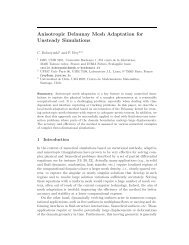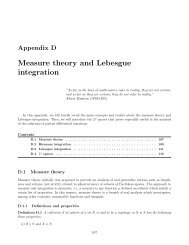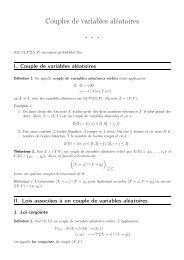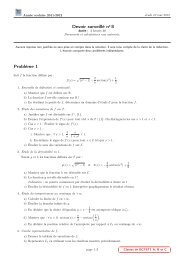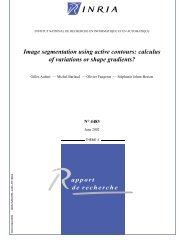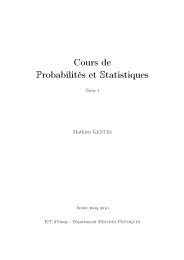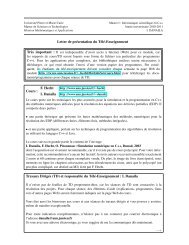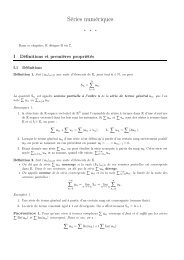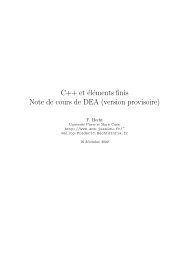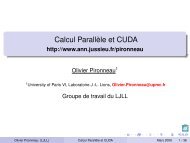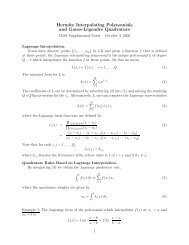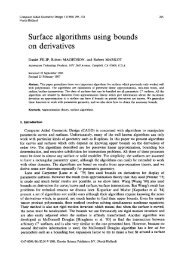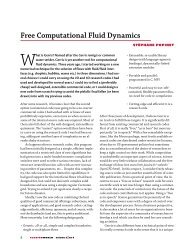pdf file
pdf file
pdf file
You also want an ePaper? Increase the reach of your titles
YUMPU automatically turns print PDFs into web optimized ePapers that Google loves.
8 M. LEWIN, P. T. NAM, S. SERFATY, AND J. P. SOLOVEJ<br />
Hessian in (11). More precisely, this means replacing v(x) by an operator<br />
a∗ (x) which creates an excited particle at x, and v(x) by an operator a(x)<br />
which annihilates it. These operators (formally) act on the Fock space of<br />
excited particles<br />
F+ := C⊕ � n�<br />
H+ = C⊕ �<br />
H n +.<br />
n≥1 sym<br />
n≥1<br />
So the expression of the Bogoliubov Hamiltonian is<br />
�<br />
H := a<br />
Ω<br />
∗ (x) � (h+K1)a � (x)dx<br />
+ 1<br />
� �<br />
2<br />
Ω<br />
Ω<br />
�<br />
K2(x,y)a ∗ (x)a ∗ (y)+K2(x,y)a(x)a(y)<br />
�<br />
dxdy. (12)<br />
In order to make the formula (12) more transparent, let us explain how<br />
the Hamiltonian H acts on functions of F+. If we have a ψk ∈ Hk + , with<br />
k ≥ 2, then we get<br />
Hψk = ···0⊕ ψ ′ k−2<br />
����<br />
∈H k−2<br />
⎛ ⎞<br />
k�<br />
⊕0⊕ ⎝ (h+K1)j ⎠ψk<br />
j=1<br />
+ � �� �<br />
∈Hk ⊕0⊕ ψ<br />
+<br />
′ k+2<br />
����<br />
∈H k+2<br />
⊕0··· (13)<br />
+<br />
where<br />
ψ ′ k+2 (x1,...,xk+2)<br />
1 �<br />
= � K2(xσ(1),xσ(2))ψk(x σ(3),...,x σ(k+2)),<br />
k!(k +2)! σ∈Sk+2<br />
ψ ′ k−2 (x1,...,xk−2) = � � �<br />
k(k −1) dxkK2(xk−1,xk)ψk(x1,...,xk).<br />
dxk−1<br />
Ω<br />
Thelink between the formal expression (12) and therigorous formula(13)<br />
is explained in [31, Sec. 1]. See also (67) in Appendix A for another equivalent<br />
expression of H using one-body density matrices.<br />
Let us remark that for ψ ′ k+2 to be in L2 (Ω k+2 ) for all ψk ∈ L 2 (Ω k ), it<br />
is necessary and sufficient to have K2(.,.) in L 2 (Ω 2 ), which is the same as<br />
assuming that K2 is a Hilbert-Schmidt operator, as required in Assumption<br />
(A2).<br />
Since K1 and K2 are Hilbert-Schmidt, the Hamiltonian H is well defined<br />
on states living in truncated Fock spaces and in the domain of h:<br />
� M� n�<br />
D(h). (14)<br />
M≥0 n=0 sym<br />
The following theorem tells us that H is bounded from below and it is a<br />
well-defined self-adjoint operator by the Friedrichs method with the form<br />
domain being the same as that of dΓ(1 + h) on F+. Here we have used<br />
the usual notation dΓ(A) for the second quantization in Fock space of an<br />
operator A acting on the one-body space H+:<br />
∞� m�<br />
�<br />
dΓ(A) := Aj = a ∗ (x) � Aa � (x)dx. (15)<br />
m=0 j=1<br />
Ω<br />
Ω



